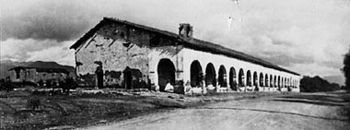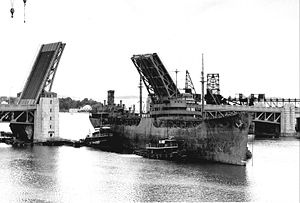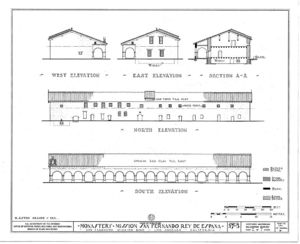Mission San Fernando Rey de España
 The convento building at Mission San Fernando Rey de España, circa 1910.[1] The convento building at Mission San Fernando Rey de España, circa 1910.[1]
| |
| HISTORY | |
|---|---|
| Location: | Los Angeles, California |
| Name as Founded: | La Misión del Señor Fernando, Rey de España [2] |
| English Translation: | The Mission of Saint Ferdinand, King of Spain |
| Patron Saint: | Ferdinand III of Castile [3] |
| Nickname(s): | "Mission of the Valley" [4] |
| Founding Date: | September 8, 1797 [5] |
| Founded By: | Father Fermín Lasuén [6] |
| Founding Order: | Seventeenth [3] |
| Military District: | Second [7] |
| Native Tribe(s): Spanish Name(s): |
Tataviam, Tongva [8] Fernandeño, Gabrielińo [8] |
| Native Place Name(s): | 'Achooykomenga, Pasheeknga [9] |
| SPIRITUAL RESULTS | |
| Baptisms: | 2,784 [10] |
| Marriages: | 827 [10] |
| Burials: | 1,983 [10] |
| DISPOSITION | |
| Secularized: | 1834 [3] |
| Returned to the Church: | 1861 [3] |
| Governing Body: | Roman Catholic Diocese of Los Angeles |
| Current Use: | Chapel-of-ease / Museum |
| Coordinates: | 34°16′08″N, 118°27′55″W |
| National Historic Landmark: | #NPS–71001076 |
| Date added to the NRHP: | 1999 |
| California Historical Landmark: | #157 |
Mission San Fernando Rey de España was founded on "The Feast of the Birth of the Blessed Virgin Mary" (September 8), 1797, the seventeenth in the twenty-one mission Alta California chain established by Spanish Catholics of the Franciscan Order. Located on the former Encino Rancho in the Mission Hills community of northern Los Angeles, the settlement is situated near the site of the first gold discovery in Alta California.[6]
Another mission bearing the name San Fernando Rey de España is La Misión San Fernando Rey de España de Velicatá which was founded in 1769 in Baja California.
Precontact
History
Mission San Fernando Rey de España was founded on September 8, 1797 by Father Fermín Lasuén, making it the fourth mission site he had established in as many months. The prime location the padre selected, located along the principal highway leading to the Pueblo de Los Angeles, had been occupied by Francisco Reyes (then Los Angeles' mayor). However, after brief negotiations construction of the first buildings was soon underway (Mission records list Reyes as godfather to the first infant baptized at San Fernando).[11]
In 1845, Governor Pío Pico declared the Mission buildings for sale and, in 1846, made Mission San Fernando Rey de España his headquarters. The Mission was utilized in a number of ways during the late 1800s: it was a station for the Butterfield Stage Lines; it served as a warehouse for the Porter Land and Water Company; and in 1896, the quadrangle was used as a hog farm. San Fernando's church became a working church again in 1923 when the Oblate priests arrived. Many attempts were made to restore the old Mission from the early 1900s, but it was not until the Hearst Foundation gave a large gift of money in the 1940s, that the Mission was finally restored. In 1971, a large earthquake damaged the church, which had to be completely rebuilt. The repairs were completed in 1974. It continues to be very well cared for and is still used as a chapel-of-ease. In 2003 comedian Bob Hope was interred in the Bob Hope Memorial Gardens.
Other historic designations
- National Register of Historic Places #NPS–88002147 — Convento Building
- Los Angeles Historic–Cultural Monument #23
- Los Angeles Historic–Cultural Monument #2355 — Convento Building
Mission industries
The goal of the missions was, above all, to become self-sufficient in relatively short order. Farming, therefore, was the most important industry of any mission. Prior to the establishment of the missions, the native peoples knew only how to utilize bone, seashells, stone, and wood for building, tool making, weapons, and so forth. The missionaries discovered that the Indians, who regarded labor as degrading to the masculine sex, had to be taught industry in order to learn how to be self-supportive. The result was the establishment of a great manual training school that comprised agriculture, the mechanical arts, and the raising and care of livestock. Everything consumed and otherwise utilized by the natives was produced at the missions under the supervision of the padres; thus, the neophytes not only supported themselves, but after 1811 sustained the entire military and civil government of California.[12]
Mission bells
Bells were vitally important to daily life at any mission. The bells were rung at mealtimes, to call the Mission residents to work and to religious services, during births and funerals, to signal the approach of a ship or returning missionary, and at other times; novices were instructed in the intricate rituals associated with the ringing the mission bells. A hundred-pound bell was unearthed in an orange grove near the Mission in 1920. It carried the following inscription (translated from Russian): "In the Year 1796, in the month of January, this bell was cast on the Island of Kodiak by the blessing of Archimandrite Joaseph, during the sojourn of Alexsandr Baranov." It is not known how this Russian Orthodox artifact from Kodiak, Alaska made its way to a Catholic mission in Southern California.
Notes

USNS Mission Fernando (T-AO-122) was the twelfth of twenty-seven Mission Buenaventura-class fleet oilers built during World War II for service in the United States Navy.[13] Seen here under tow entering the Quincy, Massachusetts shipyard for conversion to a "Missile Range Instrumentation Ship," she was the only U.S. Naval vessel to have borne the name.
- ↑ (PD) Photo: William Amos Haines
- ↑ Leffingwell, p. 49
- ↑ 3.0 3.1 3.2 3.3 Krell, p. 263
- ↑ Ruscin, p. 137
- ↑ Yenne, p. 148
- ↑ 6.0 6.1 Ruscin, p. 196
- ↑ Forbes, p. 202
- ↑ 8.0 8.1 Yenne, p. 151
- ↑ Ruscin, p. 195
- ↑ 10.0 10.1 10.2 Krell, p. 315: as of December 31, 1832; information adapted from Engelhardt's Missions and Missionaries of California.
- ↑ Young, p. 39
- ↑ Engelhardt 1922, p. 211
- ↑ Mission San Fernando
